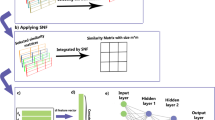Abstract
A drug-drug interaction(DDI) was defined as the pharmacological effect(s) of a drug influenced by another drug. The positive DDIs can improve the therapeutic effect of patients. However, the negative DDIs can lead serious results, such as drug withdrawal from market and even patient death. Currently, multiple pharmaceutical drugs have widely been used to treat complex diseases, such as cancer. The traditional biomedical experiments are very time-consuming and very costly to validate new DDIs. Therefore, it is appealing to develop computational methods to discover potential DDIs. In this study, we propose a new computational method (called IDNDDI) to predict novel DDIs. Based on the binary vector of drug chemical, biological and phenotype data, IDNDDI computes the integrated drug feature similarity by the cosine similarity method. In addition, the node-based drug network diffusion method is used to calculate the relational initial scores for new drugs. To systematically evaluate the prediction performance of IDNDDI and compare it with other prediction methods, we conduct the 5-fold cross validation and de novo drug validation. In terms of the AUC (area under the ROC curve)value, IDNDDI achieves the better prediction performance in the 5-fold cross validation, specifically, the AUC value is 0.9691, which is larger than the state-of-the-art L1E (L1 Classifier ensemble method) results of 0.9570. In addition, IDNDDI also obtains the best prediction result in the de novo drug validation and the AUC reaches 0.9292. The prediction ability in application of our method is also illustrated by case studies. IDNDDI is an effective DDI prediction method which can help to reduce adverse drug reactions and improve the efficiency of drug development progress.
Access this chapter
Tax calculation will be finalised at checkout
Purchases are for personal use only
Similar content being viewed by others
References
Kusuhara, H.: How far should we go? Perspective of drug-drug interaction studies in drug development. Drug Metab. Pharmacokinet. 29(3), 227–228 (2014)
Chou, T.C.: Drug combination studies and their synergy quantification using the Chou-Talalay method. Cancer Res. 70(2), 440–446 (2010)
Tatonetti, N.P., Fernald, G.H., Altman, R.B.: A novel signal detection algorithm for identifying hidden drug-drug interactions in adverse event reports. J. Am. Med. Inform. Assoc. 19(1), 79–85 (2011)
Gottlieb, A., Stein, G.Y., Oron, Y., Ruppin, E., Sharan, R.: INDI: a computational framework for inferring drug interactions and their associated recommendations. Mol. Syst. Biol. 8(1), 592 (2012)
Vilar, S., et al.: Similarity-based modeling in large-scale prediction of drug-drug interactions. Nat. Protoc. 9(9), 2147–2163 (2014)
Zhang, P., Wang, F., Hu, J., Sorrentino, R.: Label propagation prediction of drug-drug interactions based on clinical side effects. Sci. Rep. 5, 12339 (2015)
Jin, B., Yang, H., Xiao, C., Zhang, P., Wei, X., Wang, F.: Multitask dyadic prediction and its application in prediction of adverse drug-drug interaction. AAA I, 1367–1373 (2017)
Vilar, S., Uriarte, E., Santana, L., Tatonetti, N.P., Friedman, C.: Detection of drug-drug interactions by modeling interaction profile fingerprints. PLoS One 8(3), e58321 (2013)
Zhang, W., Chen, Y., Liu, F., Luo, F., Tian, G., Li, X.: Predicting potential drug-drug interactions by integrating chemical, biological, phenotypic and network data. BMC Bioinform. 18(1), 18 (2017)
Tatonetti, N.P., Patrick, P.Y., Daneshjou, R., Altman, R.B.: Data-driven prediction of drug effects and interactions. Sci. Transl. Med. 4(125), 125ra31 (2012)
Law, V., et al.: DrugBank 4.0: shedding new light on drug metabolism. Nucl. Acids Res. 42(D1), D1091–D1097 (2013)
Kanehisa, M., Goto, S., Furumichi, M., Tanabe, M., Hirakawa, M.: KEGG for representation and analysis of molecular networks involving diseases and drugs. Nucl. Acids Res. 38(suppl. 1), D355–D360 (2009)
van Laarhoven, T., Nabuurs, S.B., Marchiori, E.: Gaussian interaction profile kernels for predicting drug-target interaction. Bioinformatics 27(21), 3036–3043 (2011)
Yan, C., Wang, J., Ni, P., Lan, W., Wu, F.X., Pan, Y.: DNRLMF-MDA: predicting microRNA-disease associations based on similarities of microRNAs and diseases. IEEEACM Trans. Comput. Biol. Bioinform. (2017, to be published). https://doi.org/10.1109/TCBB.2017.2776101
Yan, C., Wang, J., Lan, W., Wu, F.X., Pan, Y.: SDTRLS: predicting drug-target interactions for complex diseases based on chemical substructures. Complexity (2017)
Chen, Y., Xu, R.: Context-sensitive network-based disease genetics prediction and its implications in drug discovery. Bioinformatics 33(7), 1031–1039 (2017)
Acknowledgement
The authors are very grateful to the anonymous reviewers for their constructive comments which have helped significantly in revising this work. The authors would like to express their gratitude for the support from the National Natural Science Foundation of China under Grant No. 61772552, No. 61420106009, No. 61622213 and No. 61732009.
Author information
Authors and Affiliations
Corresponding author
Editor information
Editors and Affiliations
Rights and permissions
Copyright information
© 2019 Springer Nature Switzerland AG
About this paper
Cite this paper
Yan, C., Duan, G., Zhang, Y., Wu, FX., Pan, Y., Wang, J. (2019). IDNDDI: An Integrated Drug Similarity Network Method for Predicting Drug-Drug Interactions. In: Cai, Z., Skums, P., Li, M. (eds) Bioinformatics Research and Applications. ISBRA 2019. Lecture Notes in Computer Science(), vol 11490. Springer, Cham. https://doi.org/10.1007/978-3-030-20242-2_8
Download citation
DOI: https://doi.org/10.1007/978-3-030-20242-2_8
Published:
Publisher Name: Springer, Cham
Print ISBN: 978-3-030-20241-5
Online ISBN: 978-3-030-20242-2
eBook Packages: Computer ScienceComputer Science (R0)




